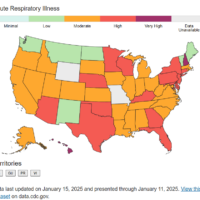COVID-19 hospitalizations at Jennie Stuart Medical Center have declined from a recent peak, but newly released federal data show the hospital continues to be under what health care experts consider “extreme stress.”
From Jan. 15 to 21, 21% of inpatient beds at Jennie Stuart were occupied by patients with coronavirus. The percentage was down from 31% the week before.
According to a framework established by health experts at the University of Washington’s Institute for Health Metrics and Evaluation, anything more than 20% is considered “extreme stress.”
Because COVID-19 patients require more resources than typical patients and are often sicker, coronavirus admissions can predict the level of strain on a hospital, according to health experts.
For eight of the last 10 reporting weeks, 20% or more of Jennie Stuart’s beds have been occupied by coronavirus patients. The ratio was 19% the week of Dec. 25 and 16% the week of Dec. 4. Anything between 10% and 19% is considered “high stress.”
Jennie Stuart ICU occupancy decreased by 46%
Jennie Stuart saw a significant decline in the number of COVID-19 patients being treated in the hospital’s intensive care unit.
From Jan. 15 to 21, 36% of ICU beds were occupied by COVID-19 patients, compared to 67% the week before.
According to the Institute for Health Metrics and Evaluation, anything between 30% and 59% indicates an ICU is under “high stress.” Anything above 60% is considered “extreme stress.”
Overall occupancy in the ICU was 57% during the last reporting week, down from 76% the week before.
County, state see increase in COVID-19 deaths
An increase in hospitalizations typically is preceded by a surge in COVID-19 cases a couple of weeks earlier. Deaths tend to spike following virus-related hospitalizations.
Recent reports from local and state health officials are a reflection of this trend within the last month.
While cases have decreased from a surge that began late last month and hospital occupancy is down, COVID-19 deaths are up in Christian County and statewide.
On Thursday, Gov. Andy Beshear confirmed the largest single-day total of coronavirus deaths since the pandemic began.
In Christian County, health officials have already confirmed 17 deaths since Jan. 1, surpassing the previous record of 14 COVID-19 deaths in November well before the month’s end. December saw 12 local virus-related deaths.
Despite recent developments regarding COVID-19 vaccines, IHME experts predict that the pandemic’s death toll nationwide will grow to 569,000 by May 1, according to Jan. 21 models using data that include mobility trends, mask use, testing per capita and social distancing mandates. Projections to not take into account the potential spread of recently discovered COVID-19 variants.
“Key strategies for both managing the end of this fall/winter surge and mitigating the risk of new variants continue to include emphasizing expanding mask use from 76% to 95%, encouraging social distancing through appropriate mandates, and accelerating vaccination,” the results briefing states.
If governments ease social distancing mandates with no re-imposition, IHME’s projections indicate the death toll would grow by another 52,000. However, models forecast 22,000 fewer deaths with an increase in mask usage to 95%.
As of Monday, the national coronavirus death toll was 411,823.
Julia Hunter is the engagement editor for Hoptown Chronicle. Reach her at julia@hoptownchronicle.org.





